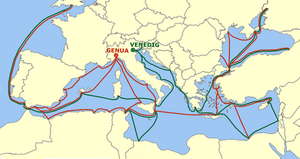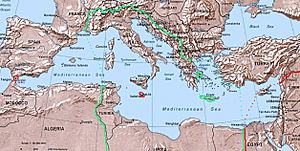History of the Mediterranean region facts for kids
The history of the Mediterranean region is super important! It helps us understand how many ancient cultures and people grew and changed. Think of groups like the ancient Egyptians, Greeks, Romans, and many more. The Mediterranean Sea was like a giant highway. It connected people from Western Asia, North Africa, and Southern Europe. This allowed them to trade, share ideas, and learn from each other.
Contents
Early History

Some of the oldest human sites in Europe are found around the Mediterranean Sea. Places like Lézignan-la-Cèbe in France and Orce in Spain show us where early humans lived.
Amazing evidence of stone tools was found on Crete from 130,000 years ago. This tells us that early humans could use boats to travel to islands!
The first "civilizations" began in Southwest Asia. These were organized societies with cities. This happened around 8000 BC, with places like Çatalhöyük. Real urban civilizations started in Egypt and Mesopotamia around 5000-4000 BC.
The Black Sea area was also a very important place for early European civilization. Solnitsata (5500-4200 BC) might be the oldest town in Europe. It was a fortified stone settlement. The first gold items in the world were found here, too! For example, at the Varna Necropolis in Bulgaria, gold items from 4569–4340 BC were discovered.
The Bronze Age started in this region around 3000 BC. Cities in the Fertile Crescent began using writing systems and developed organized governments. This led to the first empires. By 2000 BC, the Hittite Empire and Egyptian Empire were powerful. They fought for control over cities in the Levant. The Minoans were also busy trading across the Mediterranean.
Around 1200 BC, something big happened called the Bronze Age collapse. Many powerful kingdoms like the Mycenaean kingdoms and the Hittite Empire fell apart. Cities were destroyed, and long-distance trade stopped. It was a tough time! But after this "Dark Age," new kingdoms rose, like the Neo-Assyrian Empire.
During the Iron Age, the whole Mediterranean region became important. This was thanks to the Phoenicians. They were great sailors and traders from the Levant. They spread their culture and goods everywhere, starting around 1200 BC. The Phoenicians were like an early "world-economy" surrounded by empires. They also helped spread alphabetic writing, which became a key feature of Mediterranean civilizations.
Classical Antiquity

Two of the most famous Mediterranean civilizations in ancient times were the Greek city-states and the Phoenicians. The Greeks spread their influence to the shores of the Black Sea, Southern Italy, and Asia Minor. The Phoenicians traveled west, reaching North Africa and the Iberian Peninsula.
Persian Period
From the 500s BC to the mid-300s BC, the powerful Persian Empire ruled many Mediterranean people. This made them very strong in the region. The empire, started by Cyrus the Great, included places like Macedonia, Thrace, Egypt, and the Phoenician lands. Darius the Great was the first Persian king to build a large navy. Both the Phoenicians and Greeks helped provide ships for this navy. Persian power in the Mediterranean ended after the Greco-Persian War in the 400s BC. Later, Alexander the Great defeated Persia in the 300s BC.
Hellenistic Period
In ancient Macedonia, a kingdom in northern Greece, a strong army was built. Under Alexander the Great, this army moved east. They defeated the Persians and created a huge empire. This empire included Greece, Bulgaria, Egypt, and many other Mediterranean areas.
Many important Mediterranean cities became part of Alexander's empire. After his death, his empire broke apart. But Alexander's conquests spread Greek knowledge and ideas all over the region.
Roman–Carthaginian Rivalry
Later, powers in the west became more important. In North Africa, the city of Carthage grew strong. It was a former Phoenician colony. But a city on the Italian Peninsula, Rome, would eventually rule the entire Mediterranean. Rome first spread through Italy. Then, it defeated Carthage in the Punic Wars. This happened even though Hannibal famously fought against Rome.
After the third Punic War, Rome became the main power in the Mediterranean. The Romans then spread east, taking over Greece. They spread Latin ideas and knowledge everywhere. At this time, coastal trading cities became more important than inland river valleys. For example, Egyptian power moved from Nile cities to coastal ones like Alexandria.
Roman Mare Nostrum
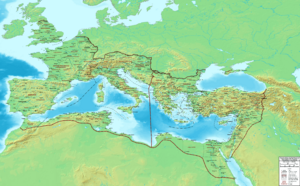
When Augustus started the Roman Empire, the Romans called the Mediterranean Sea Mare Nostrum. This means "Our Sea" in Latin. Their empire was built around this sea. There was a lot of trade and naval activity. For the first time, the entire Mediterranean was free of pirates! For several centuries, it was like a "Roman Lake," completely surrounded by the empire.
However, the empire began to weaken in the 400s AD. Rome eventually fell in 476 AD.
Byzantine Times
The Eastern Roman, or Byzantine Empire, became powerful in the eastern Mediterranean. They fought many wars with the Persians. The Byzantines kept control of the Mediterranean Sea for a long time. But in the 600s AD, the Sasanians took some Mediterranean lands. Eventually, the Byzantines lost their power in the region due to invasions by the Arabs and later the Turks.
Middle Ages

A new power, Islam, was growing in the east. The Byzantine and Persian empires were tired from centuries of fighting. Arab armies, inspired by Islam, quickly conquered most of the Middle East. They took more than half of the Byzantine lands and all of the Persian Empire.
These Arab invasions changed trade routes. Trade between Western and Eastern Europe was disrupted. But new routes opened, like across the Caspian Sea. Goods like silk and spices were carried from Egypt to ports like Venice. Viking raids also affected trade in Western Europe. But the Vikings also developed new trade routes.
The strong First Bulgarian Empire was a major European rival in the Balkan part of the Mediterranean. It lasted from the 600s to the 1300s. It left an important cultural, political, and religious legacy.
In Anatolia, the Byzantines stopped the Muslim expansion. But Byzantine areas like Syria, North Africa, and Sicily were conquered. In the far west, the Muslims crossed into Spain. They were finally stopped in southern France. At its largest, the Arab Empire controlled three-quarters of the Mediterranean coast. It connected trade between the Indian Ocean and the Mediterranean.
Between 831 and 1071, the Emirate of Sicily was a major center of Islamic culture. After Christians conquered it, the island developed a unique culture. It blended Latin and Byzantine influences.

The Fatimids (a Muslim dynasty) traded with Italian cities like Amalfi and Genoa before the Crusades. Documents show Amalfian merchants living in Cairo around 996.
More organized countries began to form in Europe. Kings launched Crusades to try and take back the holy land from Muslim control. The Crusades didn't succeed in this goal. But they did weaken the Byzantine Empire, which lost land to the Seljuk Turks and later the Ottoman Turks. The Crusades also made Egypt a major power in the eastern Mediterranean again.
The Crusades also boosted trade between Europe and the Middle East. Cities like Genoa, Venice, and Pisa set up colonies. They controlled trade with the East. Even though the Crusader states fell, and popes tried to stop trade with Muslim states, it continued.
Slavery
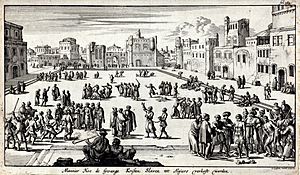
Slavery was a big part of Mediterranean societies during the Middle Ages. People like farmers, fishermen, and merchants always worried about being captured.
Here's what could happen to people:
- If pirates or commerce raiders captured someone, they could be sold to slave traders. These traders made a lot of money.
- If the captive was rich or had powerful friends, they could be ransomed. This meant their family or friends would pay money to get them back. This was often the best outcome.
- Sometimes, captives were used as workers on the pirate ships. In wars, prisoners were often taken as slaves.
Emperors would parade large numbers of prisoners through their capital cities. This was a way to show off their victories to their people and to visiting diplomats.
Late Middle Ages
Italian "Maritime Republics" like Amalfi, Venice, and Genoa built their own trading empires. Muslim states were not major naval powers. So, trade from the east to Europe soon fell into the hands of Italian traders. They made huge profits.
The Republic of Venice became very powerful in the eastern Mediterranean after the Fourth Crusade.
Between 1275 and 1344, there was a struggle for control of the Strait of Gibraltar. Many kingdoms and cities were involved, like the Marinid Sultanate, Crown of Castile, and Crown of Aragón. The Crown of Aragon dominated the Western Mediterranean. They controlled Sicily, Naples, Sardinia, and the Balearic Islands.
In 1347, the terrible Black Death spread across the Mediterranean.
The Ottoman Empire grew stronger. In 1453, they conquered Constantinople, ending the Byzantine Empire. The Ottomans already controlled Greece and much of the Balkans. They soon spread into North Africa. North Africa had been rich from trade across the Sahara Desert. But the Portuguese found a new way to trade directly with West Africa by sailing around it. This was possible thanks to new ships called caravels. This new sea route weakened North Africa, making it easier for the Ottomans to conquer.
During the Middle Ages, Christian and Muslim kingdoms often banned trading weapons and other important goods with their enemies. The popes forbade exports to the Islamic world. The Ottomans also banned exporting weapons to Christian states. But despite these rules, smuggling still happened on both sides.
Modern Era
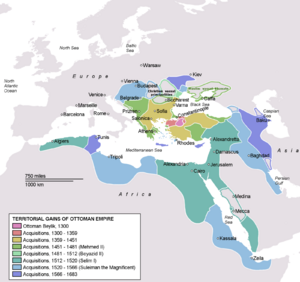
European naval power grew. The Battle of Lepanto (1571) slowed down the Ottoman navy. But it didn't stop them completely. The Ottomans took Cyprus in 1571 and Crete in 1669.
A balance of power was set up between the Spanish Empire and the Ottoman Empire. Each controlled their half of the Mediterranean until the 1700s.
The development of long-distance sailing changed everything for the Mediterranean. Before, all trade from the east passed through the region. But now, ships could sail around Africa. This allowed gold, spices, and dyes to go directly to Atlantic ports in Western Europe. The Americas also brought huge wealth to Western powers. Many Mediterranean states were left out of this new trade.
European power shifted north. Once-rich Italy became less important. The Ottoman Empire also slowly declined. Its North African lands became independent. Its European lands were taken by Austria and Russia. After a war in 1774, Russia gained direct access to the Black Sea.
By the 1800s, European countries were much more powerful. They began to colonize North Africa. France conquered Algiers in 1830. Britain took Gibraltar (1713), Malta (1814), and Cyprus (1878). Britain also occupied Egypt in 1882. The Suez Canal opened during this time. This made trade between Asia, East Africa, and Europe much faster. Mediterranean countries benefited from this shorter route. Italy conquered Libya from the Ottomans in 1911. Greece became independent in 1832.
The Ottoman Empire finally collapsed after World War I. Its lands were divided between France and Britain. The country of Turkey became independent in 1923.
In the first half of the 1900s, the Mediterranean was central to Italy's expansion. It was also a main battle area during World War II. After the war, the Mediterranean became a place of tension during the Cold War. Countries like Turkey, Greece, Spain, Italy, and France joined NATO. Syria was pro-Soviet. The United States Sixth Fleet used the Mediterranean as a base.
Today, the Mediterranean Sea is the southern border of the European Union. It is one of the biggest trade areas in the world. Sadly, many migrants try to cross the sea and drown. After a shipwreck in 2013, Italy started Operation Mare Nostrum. This was a military and humanitarian effort to rescue migrants and stop human traffickers.
See also
 In Spanish: Historia de la región mediterránea para niños
In Spanish: Historia de la región mediterránea para niños
- Eastern Mediterranean
- History of Anatolia
- History of Europe
- History of the Middle East
- History of North Africa
- History of the Levant
- History of Western civilization
- Life zones of the Mediterranean region
- Mediterranean Basin
- Union for the Mediterranean




